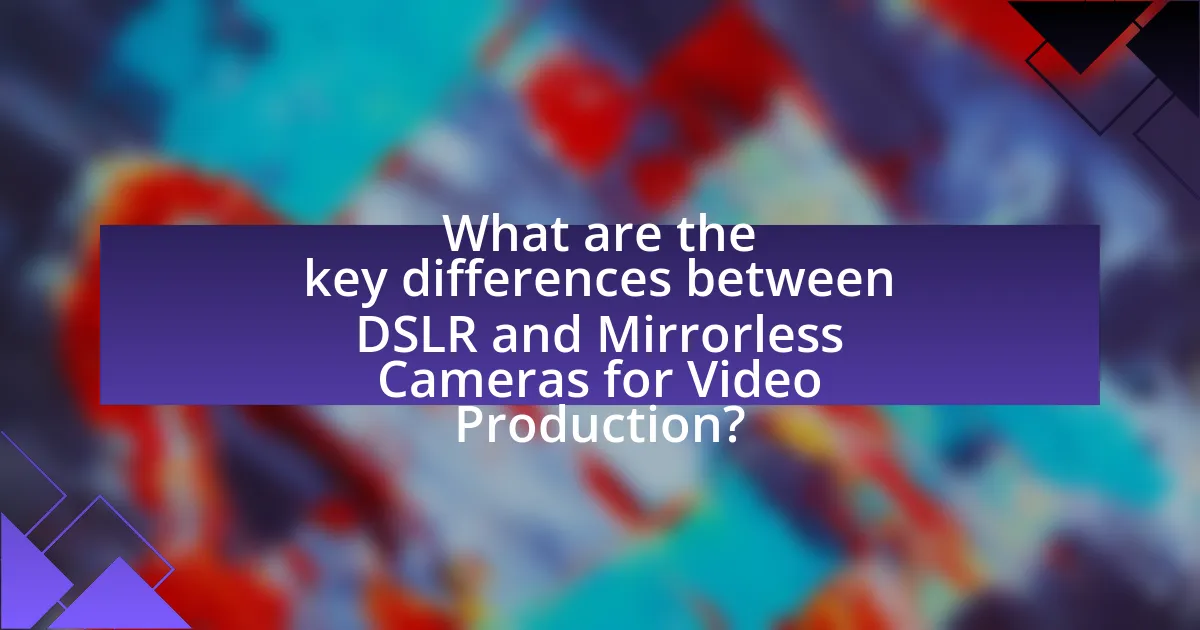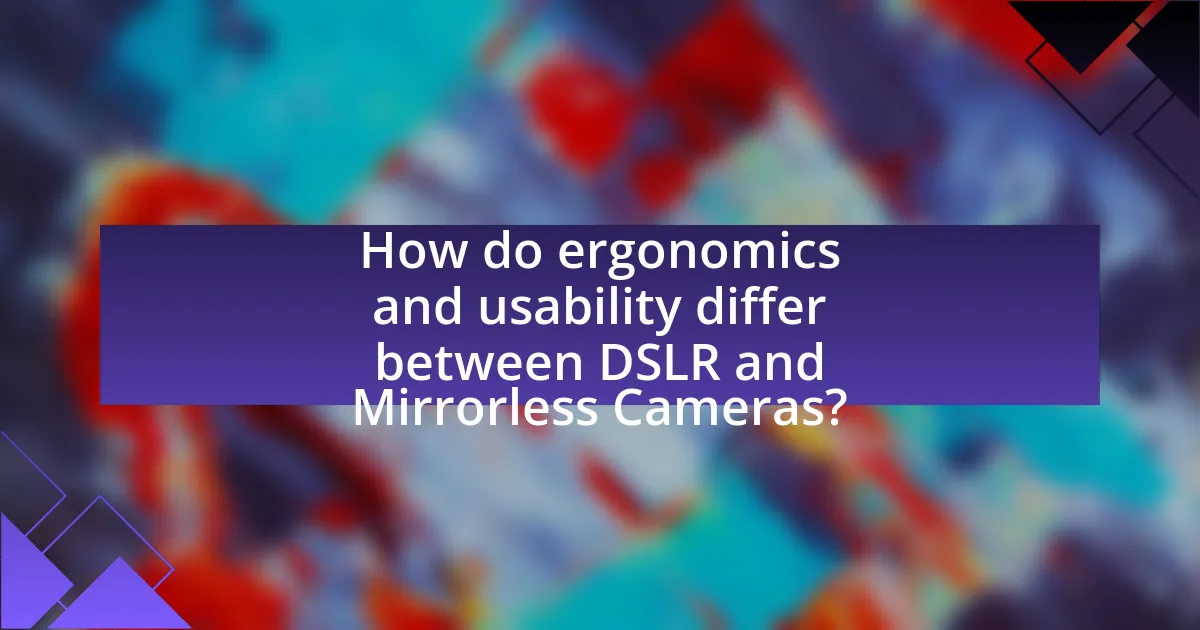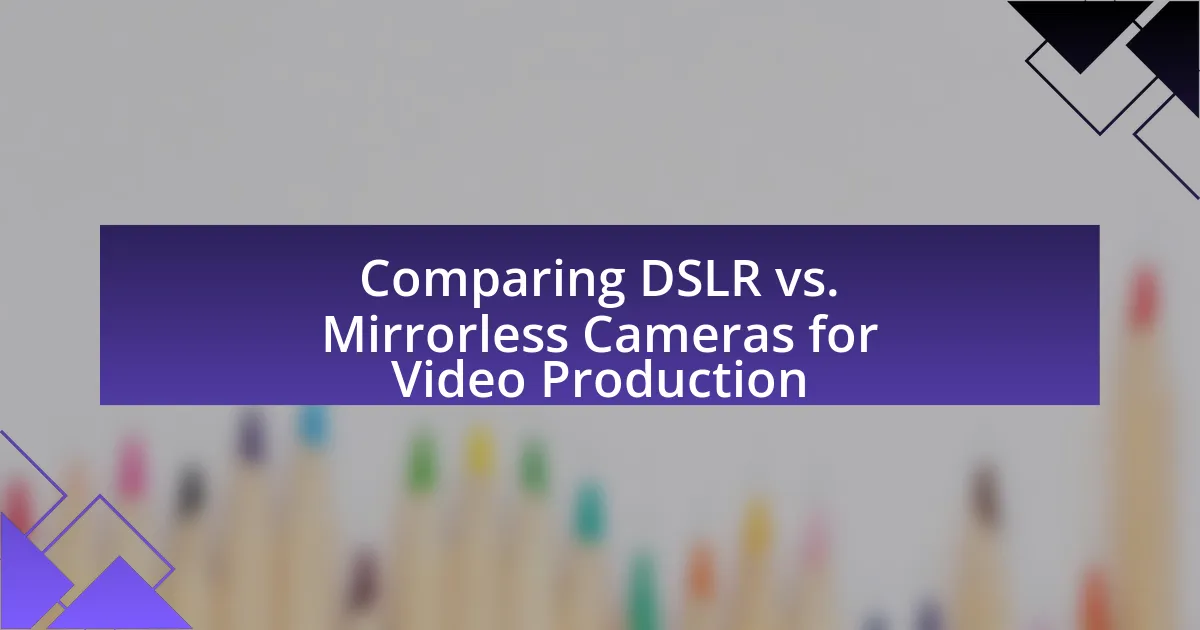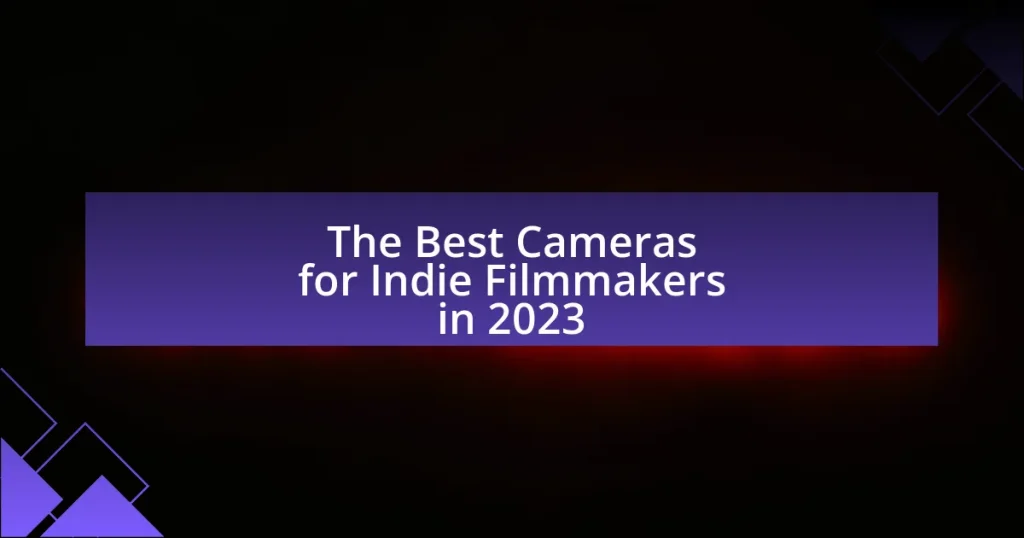The article compares DSLR and mirrorless cameras specifically for video production, highlighting key differences in autofocus performance, size and weight, battery life, and lens selection. It examines sensor technologies, low-light performance, and the impact of sensor size on video quality, while also discussing the advantages and disadvantages of each camera type. Additionally, the article addresses ergonomics, usability, and the implications of viewfinder technologies on the shooting experience. Budget considerations, long-term investment factors, and best practices for selecting a camera based on individual video production needs are also explored, providing a comprehensive guide for filmmakers.

What are the key differences between DSLR and Mirrorless Cameras for Video Production?
The key differences between DSLR and mirrorless cameras for video production include autofocus performance, size and weight, battery life, and lens selection. DSLRs typically utilize phase-detection autofocus, which can be faster for still photography but may lag in video mode, while mirrorless cameras often employ contrast-detection or hybrid autofocus systems that excel in video, providing smoother focus transitions.
In terms of size and weight, mirrorless cameras are generally more compact due to the absence of a mirror mechanism, making them easier to handle for extended shooting sessions. However, DSLRs tend to have longer battery life, as their optical viewfinders consume less power compared to the electronic viewfinders used in mirrorless systems.
Finally, lens selection varies, with DSLRs having a more extensive range of native lenses available due to their longer presence in the market, while mirrorless systems are rapidly expanding their offerings. These differences impact the choice of camera based on specific video production needs.
How do the sensor technologies of DSLR and Mirrorless Cameras compare?
The sensor technologies of DSLR and mirrorless cameras differ primarily in their design and functionality. DSLRs utilize a reflex mirror system that directs light from the lens to an optical viewfinder, while mirrorless cameras lack this mirror mechanism, allowing light to hit the sensor directly. This fundamental difference enables mirrorless cameras to achieve faster autofocus speeds and continuous shooting rates, as they can utilize on-sensor phase detection and contrast detection methods. Additionally, mirrorless cameras often feature larger sensors in a more compact body, which can enhance image quality and low-light performance. Studies have shown that mirrorless systems can provide superior video capabilities due to their electronic viewfinders and real-time exposure adjustments, making them increasingly popular for video production.
What impact does sensor size have on video quality in both camera types?
Sensor size significantly impacts video quality in both DSLR and mirrorless cameras by influencing factors such as depth of field, low-light performance, and dynamic range. Larger sensors typically capture more light, resulting in better image quality, especially in low-light conditions, which is crucial for video production. For instance, a full-frame sensor can produce a shallower depth of field compared to an APS-C sensor, allowing for more cinematic effects. Additionally, larger sensors generally offer a wider dynamic range, enabling better detail retention in highlights and shadows. This is supported by studies showing that cameras with larger sensors, like full-frame DSLRs and mirrorless models, outperform their smaller-sensor counterparts in various video quality metrics.
How does low-light performance differ between DSLRs and Mirrorless Cameras?
Low-light performance in DSLRs typically relies on larger sensors and optical viewfinders, which can capture more light, while mirrorless cameras often utilize electronic viewfinders and advanced sensor technology that can enhance low-light capabilities. DSLRs generally perform well in low-light conditions due to their ability to use phase detection autofocus, which is effective in dim environments. In contrast, many mirrorless cameras have improved low-light performance through features like in-body stabilization and superior noise reduction algorithms, allowing for clearer images at higher ISO settings. Studies have shown that certain mirrorless models outperform DSLRs in low-light scenarios, particularly those equipped with larger sensors and advanced processing capabilities, making them increasingly competitive for video production in challenging lighting conditions.
What are the advantages and disadvantages of using DSLRs for video production?
The advantages of using DSLRs for video production include high image quality, interchangeable lenses, and robust manual controls, which allow for greater creative flexibility. DSLRs typically feature larger sensors that capture more light, resulting in better low-light performance and depth of field control. Additionally, the extensive range of available lenses enhances versatility for various shooting scenarios.
However, the disadvantages of DSLRs for video production include bulkiness and weight, which can hinder mobility during shoots. DSLRs also often have limited video autofocus capabilities compared to mirrorless cameras, making it challenging to achieve smooth focus transitions. Furthermore, the recording time may be restricted due to overheating issues in some models, which can interrupt longer filming sessions.
How does battery life affect video shooting with DSLRs?
Battery life significantly impacts video shooting with DSLRs by determining the duration for which a camera can record without interruption. DSLRs typically consume more power during video recording due to continuous autofocus, image stabilization, and the use of the LCD screen, which can lead to shorter shooting times compared to still photography. For instance, a DSLR may provide around 30 to 60 minutes of continuous video recording on a single battery charge, depending on the model and settings. This limitation necessitates careful planning for shoots, as filmmakers must manage battery replacements or use external power sources to avoid interruptions during filming.
What lens options are available for DSLRs in video production?
DSLRs offer a variety of lens options for video production, including prime lenses, zoom lenses, and specialty lenses. Prime lenses, such as 50mm and 85mm, provide sharp images and wide apertures for low-light conditions. Zoom lenses, like 24-70mm and 70-200mm, offer versatility in framing and composition without changing lenses. Specialty lenses, including macro and fisheye lenses, allow for unique perspectives and close-up shots. The availability of these lenses enhances the creative possibilities for filmmakers using DSLRs, making them suitable for various video production needs.
What are the advantages and disadvantages of using Mirrorless Cameras for video production?
Mirrorless cameras offer several advantages for video production, including compact size, lightweight design, and advanced autofocus capabilities. Their electronic viewfinders provide real-time exposure and focus feedback, which enhances shooting accuracy. Additionally, many mirrorless models support high-resolution video recording and advanced features like in-body stabilization, which improves video quality.
However, there are disadvantages as well. Mirrorless cameras typically have shorter battery life compared to DSLRs due to their reliance on electronic displays. They may also experience overheating during extended recording sessions, which can limit shooting time. Furthermore, the availability of lenses and accessories may be more limited for some mirrorless systems compared to established DSLR options.
How does autofocus performance in video mode differ between the two types?
Autofocus performance in video mode differs significantly between DSLR and mirrorless cameras. DSLRs typically use phase-detection autofocus, which is faster but can struggle with continuous tracking during video recording, leading to potential focus inaccuracies. In contrast, mirrorless cameras primarily utilize contrast-detection autofocus, which has improved with advancements in technology, allowing for more precise focus adjustments and better tracking of moving subjects in video mode. This is supported by the fact that many modern mirrorless systems now incorporate hybrid autofocus systems that combine both phase and contrast detection, enhancing their performance in video applications compared to traditional DSLRs.
What are the benefits of in-body stabilization in Mirrorless Cameras?
In-body stabilization in mirrorless cameras significantly reduces camera shake, resulting in smoother video footage and sharper images. This technology compensates for small movements during shooting, which is particularly beneficial in handheld shooting scenarios or when using longer focal lengths. Studies have shown that in-body stabilization can improve the effectiveness of video capture by up to 5 stops, allowing for clearer images in low-light conditions and reducing the need for tripods or gimbals. This feature enhances the overall versatility and usability of mirrorless cameras for video production, making them a preferred choice for filmmakers seeking high-quality results without additional stabilization equipment.

How do ergonomics and usability differ between DSLR and Mirrorless Cameras?
Ergonomics and usability differ significantly between DSLR and mirrorless cameras primarily due to their design and functionality. DSLRs typically feature a larger body, which can provide a more stable grip and better balance, especially with larger lenses, making them comfortable for extended use. In contrast, mirrorless cameras are generally more compact and lightweight, which enhances portability but may lead to less comfortable handling for some users, particularly during prolonged shooting sessions.
The usability aspect also varies; DSLRs often have a more extensive array of physical controls and buttons, allowing for quicker adjustments without navigating through menus. This can be advantageous for users who prefer tactile feedback and immediate access to settings. Conversely, mirrorless cameras frequently rely on electronic displays and touchscreens, which can streamline the interface but may require more time to adjust settings, especially for users accustomed to traditional controls.
Research indicates that user preference in ergonomics and usability can be subjective, with some photographers favoring the robust feel of DSLRs while others appreciate the lightweight design of mirrorless systems. This preference can influence the choice of camera based on individual shooting styles and needs in video production.
What are the handling and weight differences between DSLRs and Mirrorless Cameras?
DSLRs generally have a heavier and bulkier design compared to mirrorless cameras, which are typically more compact and lightweight due to the absence of a mirror mechanism. The weight difference can be significant; for example, a typical DSLR body weighs around 800 grams, while a mirrorless camera can weigh as little as 400 grams. This reduced weight in mirrorless systems enhances portability and ease of handling, especially during extended shooting sessions. Additionally, the ergonomic design of DSLRs often includes larger grips, which can provide a more stable hold, while mirrorless cameras may require additional accessories for similar stability.
How does the size and weight of a camera affect video production on location?
The size and weight of a camera significantly impact video production on location by influencing portability, setup time, and stability. A smaller, lighter camera allows for easier transport and quicker adjustments, which is crucial in dynamic shooting environments. For instance, mirrorless cameras typically weigh less than DSLRs, enabling filmmakers to shoot for extended periods without fatigue. Additionally, the compact design of smaller cameras facilitates the use of handheld rigs and gimbals, enhancing mobility and flexibility during shoots. Conversely, larger and heavier cameras may require more robust support equipment, potentially slowing down the production process. This relationship between camera size, weight, and production efficiency is supported by industry practices where lightweight setups are preferred for on-location shoots to maximize agility and reduce logistical challenges.
What user interface features are unique to each camera type?
DSLR cameras typically feature an optical viewfinder and dedicated physical controls for settings like aperture and shutter speed, allowing for quick adjustments. In contrast, mirrorless cameras often utilize electronic viewfinders or LCD screens that display real-time exposure and focus information, providing a more intuitive interface for video production. This difference in viewfinder technology and control layout reflects the distinct design philosophies of each camera type, with DSLRs emphasizing tactile feedback and mirrorless systems prioritizing digital displays and versatility.
How do viewfinder technologies impact video production experience?
Viewfinder technologies significantly impact the video production experience by influencing how filmmakers compose shots and monitor footage. Digital viewfinders, such as electronic viewfinders (EVFs) in mirrorless cameras, provide real-time exposure and color previews, allowing for precise adjustments before recording. In contrast, optical viewfinders (OVFs) in DSLRs offer a direct optical path but lack the ability to display exposure settings or effects, which can lead to discrepancies between what is seen and what is recorded. This difference can affect decision-making during production, as EVFs enable filmmakers to see the final image as it will be captured, enhancing accuracy and efficiency in shooting. Studies indicate that the use of EVFs can improve focus accuracy and reduce the time spent on adjustments, ultimately streamlining the video production process.
What are the pros and cons of optical viewfinders versus electronic viewfinders?
Optical viewfinders (OVFs) provide a direct optical path to the scene, offering a clear, real-time view without lag, which is beneficial in bright conditions. In contrast, electronic viewfinders (EVFs) display a digital image of the scene, allowing for features like exposure previews and focus peaking, but may suffer from lag and lower resolution in certain lighting conditions.
The advantages of OVFs include their ability to function without battery power and their superior performance in bright light, as they do not rely on electronic displays. However, they lack the ability to show real-time exposure adjustments and can be less effective in low-light situations. Conversely, EVFs can provide a wealth of information, including histograms and grid overlays, enhancing the shooting experience, but they can drain battery life faster and may introduce a slight delay in the image display.
In summary, OVFs excel in clarity and battery efficiency, while EVFs offer advanced features and real-time feedback, making the choice dependent on the photographer’s needs and shooting conditions.
How does real-time exposure preview affect shooting decisions?
Real-time exposure preview significantly influences shooting decisions by allowing photographers to see the effects of exposure settings in real-time, which enhances their ability to make informed adjustments. This feature enables users to visualize how changes in aperture, shutter speed, and ISO will affect the final image, leading to more precise control over exposure and creative choices. Studies have shown that photographers using real-time exposure preview report higher satisfaction with their images, as they can quickly adapt to varying lighting conditions and achieve desired results without relying solely on trial and error.

What should you consider when choosing between DSLR and Mirrorless Cameras for video production?
When choosing between DSLR and Mirrorless Cameras for video production, consider factors such as autofocus performance, lens availability, battery life, and overall size and weight. Mirrorless cameras typically offer superior autofocus capabilities, especially for video, due to their on-sensor phase detection. DSLRs, however, have a more extensive selection of lenses available, which can be crucial for specific video needs. Battery life tends to favor DSLRs, as they can capture more footage on a single charge compared to mirrorless models, which often consume more power due to their electronic viewfinders. Additionally, the compact size and lighter weight of mirrorless cameras can enhance portability, making them more suitable for handheld shooting or travel.
What are the budget considerations for DSLRs versus Mirrorless Cameras?
Budget considerations for DSLRs versus mirrorless cameras primarily revolve around initial costs, lens availability, and accessory expenses. DSLRs typically have a lower entry price point, with many models available under $500, while mirrorless cameras often start at higher prices, generally beginning around $600. Additionally, lens options for DSLRs are more extensive and often less expensive due to their longer presence in the market, which can lead to lower overall costs for a complete setup. Conversely, mirrorless systems may require more investment in lenses and accessories, as they are still expanding their offerings. Furthermore, mirrorless cameras often necessitate additional expenditures for adapters or specialized accessories, which can further increase the budget.
How do the costs of lenses and accessories compare for both camera types?
The costs of lenses and accessories for DSLR cameras are generally higher compared to mirrorless cameras. DSLRs often require more expensive lenses due to their larger sensor sizes and the need for additional optical components, which can lead to higher prices for equivalent quality. For instance, a high-quality DSLR lens can range from $500 to over $2,000, while mirrorless lenses tend to be priced lower, often starting around $300 and going up to $1,500 for premium options. Additionally, mirrorless systems typically have a wider range of affordable third-party lenses, which can further reduce overall costs. This price difference is supported by market trends showing that mirrorless camera systems are gaining popularity partly due to their cost-effectiveness in lenses and accessories.
What are the long-term investment considerations for video production equipment?
Long-term investment considerations for video production equipment include durability, technological advancements, and resale value. Durability ensures that equipment withstands extensive use over time, which is crucial for maintaining functionality and minimizing replacement costs. Technological advancements, such as the transition from DSLR to mirrorless cameras, can impact the longevity of equipment; investing in systems that adapt to new technologies can enhance future-proofing. Resale value is significant as high-quality equipment retains value better, allowing for potential recovery of investment when upgrading. For instance, mirrorless cameras have shown a trend of higher resale values compared to older DSLR models, reflecting their growing popularity and technological relevance in the market.
What are the best practices for selecting a camera based on your video production needs?
The best practices for selecting a camera based on video production needs include assessing the type of content being produced, understanding the camera’s specifications, and considering the budget. First, identify the specific requirements of the project, such as resolution, frame rate, and low-light performance, which are crucial for achieving desired visual quality. For instance, 4K resolution is often preferred for professional projects, while frame rates like 24fps or 60fps can impact the cinematic feel.
Next, evaluate the camera’s features, including sensor size, autofocus capabilities, and lens compatibility. Larger sensors typically provide better image quality and depth of field control, while advanced autofocus systems can enhance shooting efficiency, especially in dynamic environments.
Finally, budget constraints play a significant role in camera selection. It’s essential to balance cost with the necessary features, as higher-priced models often offer superior performance and durability. Researching user reviews and professional recommendations can also guide the decision-making process, ensuring that the chosen camera aligns with both creative and practical needs.
How can you determine which camera type aligns with your shooting style?
To determine which camera type aligns with your shooting style, assess your specific needs, preferences, and the types of projects you undertake. For instance, if you prioritize portability and advanced autofocus for video, a mirrorless camera may be more suitable, as they typically offer faster focusing and lighter designs compared to DSLRs. Conversely, if you value battery life and a robust build for extensive shooting sessions, a DSLR might be preferable, as they generally have longer battery performance and a more durable body.
Research indicates that mirrorless cameras have gained popularity in video production due to their compact size and superior video features, with a 2021 study by CIPA showing that mirrorless camera sales surpassed DSLRs for the first time, reflecting a shift in user preference towards their capabilities. Therefore, evaluating your shooting style against these characteristics will help you choose the camera type that best fits your requirements.
What common mistakes should you avoid when choosing a camera for video production?
When choosing a camera for video production, avoid the mistake of prioritizing resolution over other important features. While high resolution can enhance image quality, factors such as low-light performance, autofocus capabilities, and lens compatibility are equally crucial for effective video production. For instance, a camera with excellent low-light performance can significantly improve video quality in dim environments, which is often more important than simply having a higher resolution. Additionally, neglecting to consider the ergonomics and weight of the camera can lead to discomfort during long shoots, impacting overall production quality.



